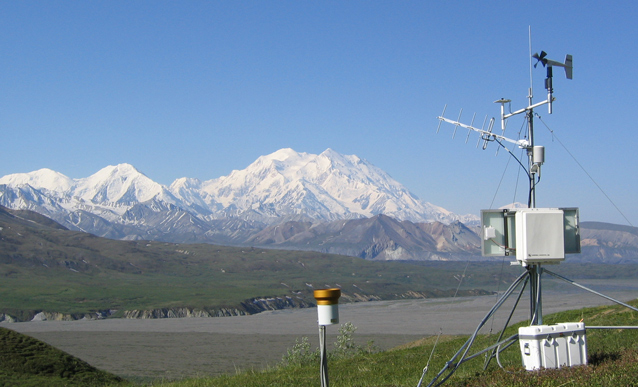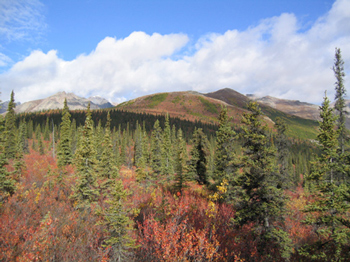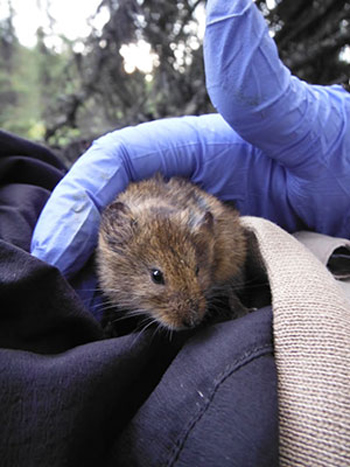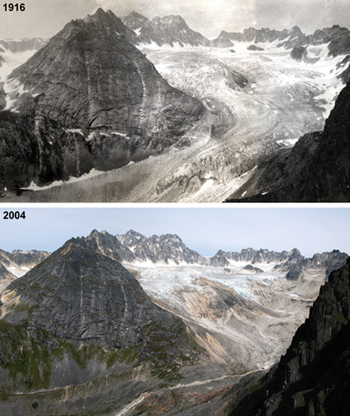
Recent climate warming has already aff ected Denali’s ecosystems in ways that are readily apparent, such as reduced snowfall in spring, earlier snowmelt, earlier green-up, shorter seasons of river and lake ice, and thawing of permanent snowfi elds. Other impacts are dramatic but less easily noticed—thawing of permafrost, changes in habitat suitability, changes in breeding times, vegetation shifts, and changes in landscape processes that infl uence wildlife distribution and habitat use.
Denali’s subarctic ecosystems are extremely sensitive to natural climate variability and to long-term natural or anthropogenic climate change. All places at high latitudes are experiencing some of the planet’s most rapid and severe climate changes. According to the 2007 Intergovernmental Panel on Climate Change (IPCC) report, average arctic temperatures have increased over the past 100 years at a rate that is nearly twice the average for the rest of the world.
Natural Influences on Denali’s Climate
Denali’s climate varies greatly across its 6 million acres. The Alaska Range divides the park into two distinct climate regimes--the transitional maritime climate, south of the Range, that is infl uenced by the ocean, and the drier continental climate, north of the mountain barrier, that is farther from ocean infl uences. Complex climate patterns exist in the park because of gradients of elevation and latitude, and eff ects of local topography. Short-term climate variability is subject to seasonal variations, annual variations (El Niño), decadal events (Pacific Decadal Oscillation), and other large-scale patterns.
Trends in Precipitation and Temperature
Park weather records dating back to 1925 indicate that annual average temperatures and precipitation amounts have increased. Evaporation has increased with higher temperatures leading to a net drying. In recent years, the number of snow-free days has increased and the growing season (defi ned by active plant growth) has lengthened. Over the past few decades, warming around the state of Alaska has averaged 4°F (2°C). Winter in Alaska’s Interior (including Denali) has experienced the largest warming (about 7°F (4°C)).
Monitoring Climate Change in Denali
Denali provides a special opportunity to study a large, intact, and naturally-functioning ecosystem. Understanding climate patterns and the ability to detect changes and their cause play a critical role in conserving unimpaired the park’s natural resources. As part of the National Park Service’s Inventory and Monitoring program, protocols are being developed for monitoring ecosystem components aff ected by climate change. Major objectives for climate monitoring are to identify long and shortterm trends, provide reliable climate data to other researchers, and contribute to larger-scale climate monitoring and modeling efforts.
Researchers and park scientists use climate data to correlate climate patterns with a wide variety of research findings. Two examples of possible correlations are:
•Reduced numbers of stream macro-invertebrates after deep snow winters (snowmelt may flush them)
•Reduced numbers of red-backed voles in some habitats in dry summers (voles may be elsewhere seeking water)
Integrating Observations of Climate Change
To assess climate change and its impact on park resources, Denali resource staff are consistently monitoring these components of environmental change and will integrate long-term observations.
Changes in Snow Cover
Very important in Denali’s winter landscape is the creation of a snow cover. Snow cover protects and insulates the ground and low-lying plants, reduces desiccation, and maintains ground temperatures that are warmer than air temperatures. Snow thickness and duration of snow cover aff ect wildlife population densities, herd movements, vegetation succession, soil temperature regimes, and hydrologic systems. Snow depth is monitored through surveys at several Denali locations.

Landscape Phenology
Tracking the seasons across the landscape (snow-free date, date of onset of greenness, date of maximum greenness, date of senescence of greenness, and snow-cover date) provides an integrated measure of climate change.
Vegetation Change
The physical environment strongly controls vegetation patterns on the landscape. Climate change (warmer temperatures) is projected to lengthen the growing season, decrease available moisture, and increase fire frequency. Existing plant communities may be modifi ed because individual plant species respond diff erently to these changes. Thus, climate change may have profound eff ects on plant diversity, vegetation communities, and on habitat attributes important to the park’s fauna. Monitoring the distribution and abundance of plant species and communities will help track how Denali’s ecosystems respond to climate change.

Changes in Wildlife Population Dynamics
If climate change aff ects plant community types, it will also change animal distribution and habitat use. For example, taiga (forest) is expected to shift northward and upslope replacing tundra because rising temperatures favor taller, denser vegetation. Tundra areas that caribou have relied on for good forage during the calving season would be reduced. Wildlife monitoring will focus on the distribution and abundance of fauna and any changes in predator – prey relationships. Golden eagles will be a special focus because they are top trophic-level predators that change their breeding activities in response to changes in their environment.
Thawing Permafrost
Continuous or discontinuous permafrost underlies most of Denali’s northern landscapes. Thawing permafrost in the last several decades has caused increased erosion, landslides, and sinking of the ground surface (thermokarst). Interior Alaska’s permafrost temperatures hover just below freezing; slight increases trigger thawing of permafrost soils. Denali’s monitoring may include measurements of permafrost extent and borehole temperatures.
Changes in Frequency and Intensity of Wildfires
Fires are dependent on long-term climate conditions. With recent warming and drying trends, the number of fire starts and the acres burned in Alaska’s Interior have increased. Fire effects on vegetation, soils, and underlying permafrost create a new dynamic mosaic in Denali’s northwest taiga and tundra where wildfi re is a dominant process. Monitoring the number of fi res, fi re extent, and burn severity can provide data that may correlate with or help explain other ecological changes.

Shrinking glaciers
Glacier systems are dominant and dynamic physical features of Denali. Because they are regulated solely by climate fl uctutions, they provide a reliable record of past climate. Monitoring changes in Denali’s glaciers (extent and mass balance) provides a measure of climate that can be compared with other climatic zones. Alaskan glaciers are showing an accelerated rate of melting. About half of the estimated loss of mass by glaciers worldwide has been contributed by Alaska glaciers.
Last updated: April 22, 2016
